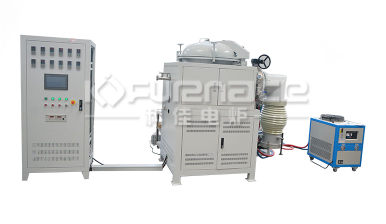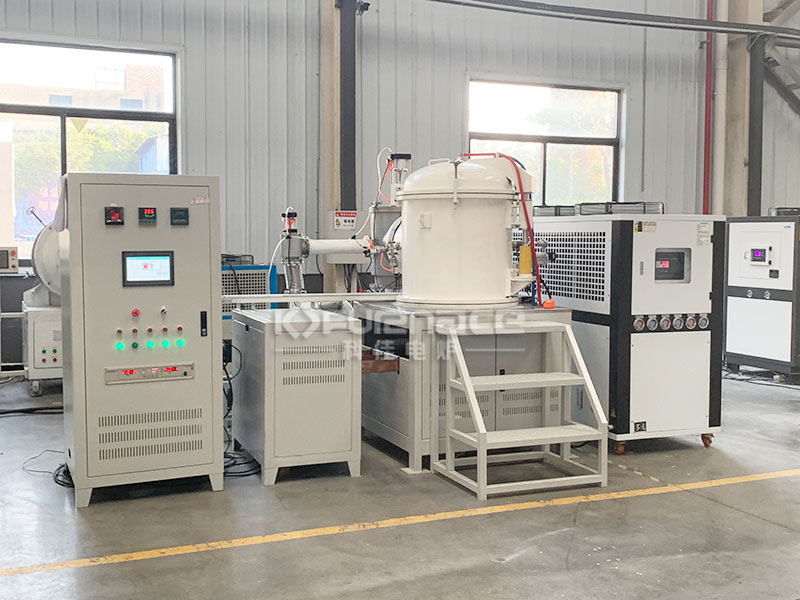Vertical vacuum furnaces have great advantages in heating uniformity, space utilization, operational convenience, and process adaptability due to their unique structural design, especially suitable for precision heat treatment, material research and development, and special industrial scenarios. Let’s take a detailed look below!

Multi heating chamber vacuum muffle furnace (click on the picture to view product details)
1. Structural advantage: Vertical layout improves performance
Optimization of Heating Uniformity
Gravity assisted convection: The vertical structure allows the hot air flow to circulate naturally in the vertical direction, coupled with a forced convection system (such as a circulating fan), which can greatly reduce the temperature difference inside the furnace (usually ≤± 5 ℃), especially suitable for uniform heating of long axis, tubular or thin section samples.
Multi layer heating zone design: By independently controlling the temperature in upper and lower zones, the power can be adjusted for different height areas, further eliminating vertical temperature gradients and meeting complex process requirements.
High space utilization rate
Compact design: Compared to horizontal furnaces, the vertical structure reduces the horizontal footprint, making it suitable for laboratories or production lines with limited space. For example, under the same volume, the footprint of a vertical furnace can be reduced by 30% -50%.
Modular expansion: It can be partitioned into multiple furnaces and designed to process multiple samples simultaneously, with independent temperature control in each compartment, greatly improving the processing capacity of a single batch.
2. Process adaptability: meet diverse needs
Accurate control of vacuum environment
High vacuum degree: Vertical furnaces are usually equipped with molecular pumps or diffusion pumps, which can achieve an ultra-high vacuum environment of 10 ⁻⁴ -10 ⁻⁶ Pa, effectively suppressing oxidation, decarburization, and gas pollution, suitable for heat treatment of active metals such as titanium and zirconium.
Atmosphere flexibility: Supports quick switching between vacuum, inert gas (Ar/N ₂), or reactive gas (such as H ₂, C ₂ H ₂) to meet process requirements such as carburizing, nitriding, and reduction.
Rapid temperature rise and fall capability
Efficient insulation layer: using multi-layer graphite felt or ceramic fiber insulation materials, combined with water-cooled jacket design, reduces heat loss, and the heating rate can reach 50-100 ℃/min (traditional furnace types usually ≤ 20 ℃/min).
Partition temperature control: Local rapid heating or cooling is achieved through independent heating modules, shortening the process cycle and improving production efficiency.
3. Operation and Maintenance: Balancing Convenience and Security
Efficient sample loading and unloading
Top loading design: Vertical furnaces are usually equipped with electric lifting platforms or quick opening furnace covers. Samples can be directly placed into the furnace through lifting or mechanical arms, reducing manual operation time.
Strong compatibility: Supports customized chemical fixtures and can handle irregular parts, batch small parts, or samples that require vertical suspension (such as long rods and thin films).
Low maintenance cost
Modular structure: Key components such as heating elements and insulation layers are designed for quick disassembly, resulting in shorter replacement times.
Convenient cleaning: There are no dead corners or ash accumulation in the vertical furnace, which can reduce maintenance frequency.
4. Application scenario: Covering high-end manufacturing fields
Aerospace: Used for vacuum brazing and annealing of titanium alloys and high-temperature alloys to avoid performance degradation caused by high-temperature oxidation.
Semiconductors and Electronics: Suitable for silicon wafer annealing, ceramic packaging, and metallization processes to prevent material contamination in vacuum or inert atmospheres.
New energy materials: used for sintering of positive electrode materials (such as NCM, LFP) for lithium batteries, achieving uniform grain growth through precise temperature control and improving battery energy density.
Research field: Support material synthesis, phase change research, and high-temperature physical performance testing, equipped with multi-channel temperature measurement systems (such as infrared+thermocouple) to monitor the temperature field distribution of samples in real time.
5. Selection suggestions
Prioritize vertical furnace scenarios:
High vacuum degree (≤ 10 ⁻⁵ Pa) or rapid temperature rise and fall (≥ 50 ℃/min) is required;
Processing samples with small size but large quantity, or requiring vertical suspension;
Limited space and pursuit of efficient loading and unloading.

Vertical graphite vacuum muffle furnace with a temperature of up to 2000 ℃ (click on the picture to view product details)
The vertical vacuum furnace provides high-precision and high-efficiency heat treatment solutions for high-end manufacturing through structural innovation and process optimization, and is one of the commonly used heat treatment equipment for material research and industrial production.Click to learn more Vacuum Furnaces! Or click on online customer service to learn more about product information!